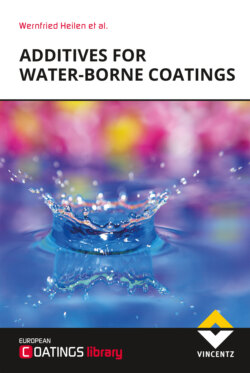Читать книгу Additives for Water-borne Coatings - Wernfried Heilen - Страница 41
На сайте Литреса книга снята с продажи.
2.5.5Zeta potential
ОглавлениеElectrostatic stabilisation can be characterised by measuring the zeta (ζ) potential which assumes formation of an electrical double layer. In a solution of electrolyte, particles with a charged surface such as metal oxide pigments adsorb counter ions which form an immobile film known as a Stern layer. The diffuse cloud of ions, consisting of similarly charged ions and counter ions lies outside this layer. If a particle moves, part of the loosely-bound diffuse layer shears off. The potential at this shear plane is termed zeta (ζ) potential and is important in assessing the stabilisation of dispersion. The higher the ζ potential, the better a dispersion is protected against flocculation.
Traditional, optical methods for determining ζ potential, which are based on electrophoretic mobility, can only be used for very dilute systems. However, strong dilution during investigation of coating of the pigment surface by additives leads, for example, to a change in the adsorption equilibrium and thus to measurements which do not correspond to reality.
The ζ potential can be measured electro-acoustically. This method is also suitable for investigating concentrated dispersions with a pigment concentration of 50 % v/v. There are two different ways of determining the ζ potential electro-acoustically depending on the exciting force. If an alternating electrical field is applied to a dispersion of charged particles, the particles are excited to vibrate and emit sound waves. This method gives the value of the electric sonic amplitude. If the exciting force is an ultrasonic wave, an electrical signal can be detected and a colloid vibration current (CVI) measured.
Figure 2.7 shows the CVI principle. A high frequency sound wave generated by a piezo crystal in the measuring sensor passes through the dispersion. The acoustic signal excites the particle to vibrate. The higher the inertia of the particles, the worse their ability to follow the sound wave and hence the larger the phase shift. The diffuse cloud of ions reacts without delay to the sound wave so that each particle with its ionic shell becomes a dipole which constantly changes its direction. At a particular point in time, the dipoles point in one direction so that an electric field arises, and the colloid vibration current can be measured with two electrodes.
Figure 2.7: CVI principle by using high frequency sound wave
Figure 2.8: Principle of the use of an ultrasonic wave as exciting force
Figure 2.8 shows a diagram of a measuring sensor. After applying a radio-frequency pulse, a cylindrical piezo element generates an acoustic pulse which passes through a quartz crystal for internal calibration. The quartz crystal is extended by a buffer section the acoustic impedance of which is more tailored to the dispersion than to the material of the quartz crystal. The end of the buffer rod is coated with gold and forms an electrode for measuring the electric signal. The second electrode required is provided by the steel casing. When the measurement sensor is immersed in a sample, a colloid vibration current can be detected between the gold electrode and the stainless-steel casing.
The measured colloid vibration current is related to the ζ potential as follows:
where
| ε 0: dielectric constant of the vacuum | Ks: conductivity of dispersion |
| ε m: dielectric constant of medium | Km: conductivity of medium |
| ζ : zeta potential | ρ p: density of particle |
| φ: parts by weight | ρ s: density of system |
| η: dynamic viscosity | ω: circular or angular frequency |
The equation shows which parameters affect the ζ potential. A higher value of dielectric constant causes a lower ζ potential. Water with a dielectric constant of 80 and a very polar character weakens the dipole while, for example, in a non-polar solvent such as heptane, the dipole effects are more pronounced. A greater concentration leads to a lower ζ potential, because the individual particles move closer together and the electrical double layers overlap as the concentration increases.
Figure 2.9: ζ potential curves based on different wetting and dispersing additives with iron oxide yellow
A high dynamic viscosity affects the inertia of the particle which causes the ion cloud to be more easily shifted against the particles in the medium. The difference in density between the particle and medium must be as great as possible so that the medium moves relative to the particle and dipoles are created which contribute to the measurement of the colloidal current.
Using additive and pH titrations, one can deduce interactions between pigments and additives and thus characterise the electrostatic stabilisation of pigments.
With iron oxide yellow pigments, it has been found that additives with a strongly ionic character promote electrostatic stabilisation while additives with polar anchor groups do not wet the surface [4]. If the pigment surface were wetted by the non-ionic additive, shielding of the partially charged pigment surface by the additive would lead to a measurable change in potential.
